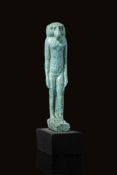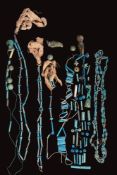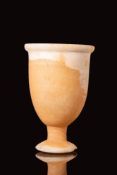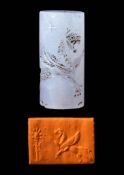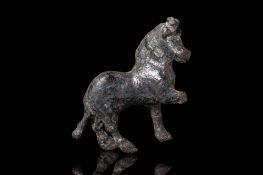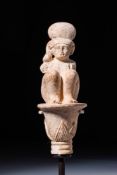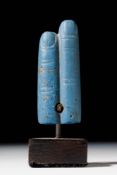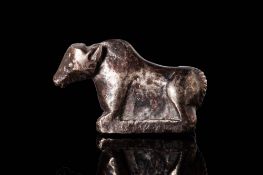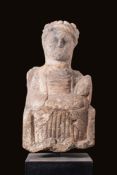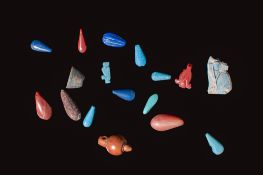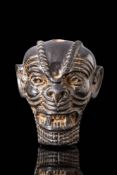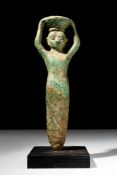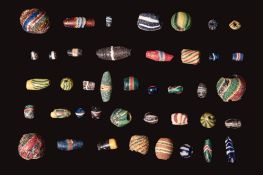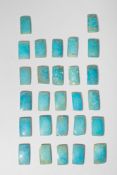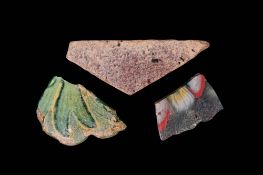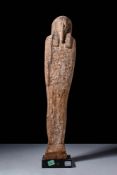Ca. 330 - 280 BC. A wheel-thrown terracotta oinochoe with tall, inverted piriform body, trefoil mouth, and high-swung handle, decorated in applie...
*
Sortieren nach:
- Nur Lose mit Abbildungen,
- Auktionshaus
- Liste
- Galerie
-
909 Los(e)/Seite
BRONZE AGE GOLD BEADS
Ca. 1500 - 1200 BC. A strand composed of numerous small gold ring-shaped beads, each with a flat profile and circular central aperture. The beads...
GREEK GOLD HOLLOW PENDANT
Ca. 400 BC. A gold pendant with a hollow, domed central element set on a diamond-shaped backing plate. Three corners of the plate are accentuated...
Ca. AD 1400. A gold 21 ct ring with a polygonal section round hoop enlarged on the shoulders and adorned with engraved motifs to form a hexagonal ...
Ca. 1600 - 1500 BC. A pale translucent yellow stone scarab with a well-defined domed back and crisp delineation of the dorsal segments. The elytra...
Ca. 400 BC. A silver ring with a broad, flat oval bezel and a tapering hoop that thickens gradually towards the shoulders. The bezel is engraved ...
Ca. AD 1600 - 1700. A gold posy ring with a rounded exterior and a flat interior. The edges are slightly pronounced, and the exterior is textured....
Ca. AD 200 - 400. An emerald intaglio engraved with the left-facing bust of Tyche, identifiable by the mural crown atop her head. The intaglio is...
Ca. 300 - 100 BC. A matched pair of gold earrings, each formed as a crescent modelled in the round, applied with twisted wire edging. The lower ed...
EGYPTIAN FAIENCE BABOON FIGURINE
Late Period, Ca. 664 - 332 BC. A turquoise-blue faience amulet in the form of a standing baboon, depicted upright with arms held closely at the s...
Ca. 550 BC. A terracotta funnel krater with a globular body, flaring rim, and a pair of vertical strap handles rising above the rim, interspersed...
Ca. 1550 - 332 BC. A group of faience necklaces and bead strands, comprising tubular, disc-shaped, and ring beads in various shades of turquoise ...
Ca. AD 1 - 100. An oval red intaglio engraved with a wine krater. The intaglio is mounted in a plain collet bezel, and the hoop broadens at the s...
Ca. 360 - 350 BC. A red-figure bell-krater attributed to the Black Thyrsus Painter, constructed with a broad bell-shaped body, flaring rim, and di...
Ca. 1938 - 1190 BC. An Egyptian alabaster conical cup with an enlarged rim. The cup sits on a flat round tall pedestal base. For similar see: Mech...
Ca. 1300 - 1200 BC. A quartz cylinder seal depicting a mythical lion standing before a schematic life tree. Studied by PD Dr. habil. Pieter Gert ...
Ca. 300 - 100 BC. A gold pendant formed from eight circular elements arranged in a rosette pattern, each composed of twisted wire. The central set...
Ca. AD 1200 - 1400. A bronze-gilt ring with an octagonal bezel engraved with a six-pointed star formed by two intersecting triangles. The central...
Ca. AD 600. A bronze cross with each arm extending to outwardly flared ends. Two circular loops are integrated into the central section of the low...
Ca. AD 100 - 200. A solid-cast bronze figurine representing a horse in profile with the right foreleg raised and head slightly tilted. The body i...
Third Intermediate Period to Late Period, Ca. 1069 - 332 BC. A collection of three amulets. The one on the left is a faience amulet of a squattin...
New Kingdom, Ca. 1550 - 1069 BC. A slender, rare stone stopper with a statuette of Harpocrates. The finely detailed portrait depicts the nude uppe...
Ca. 100 BC - AD 100. An aubergine-coloured glass bottle with an onion-shaped body, elongated cylindrical neck, and plain, upright rim. The body is...
VIKING AGE GOLD OPENWORK PENDANT
Ca. AD 800 - 1100. An openwork earring composed of filigree panels decorated with scrollwork. The surface is further embellished with five applie...
Ca. 350 - 300 BC. A shallow red-figure terracotta plate on a stepped foot, with broad offset rim, the tondo decorated with the female head in the ...
Late Period, Ca. 664 - 332 BC. A glass amulet in the form of two extended fingers, each rendered with incised lines marking the joints. The surfa...
ROMAN MILLEFIORI GLASS BOWL
Ca. AD 1 - 300. A millefiori glass bowl with a shallow, wide body and an everted rim. The surface displays vibrant polychromy, composed of fused ...
Ca. 400 BC. A solid silver figurine of a bull depicted in a seated posture with its forelegs bent and hind legs tucked beneath the body. The head ...
Ca. 460 - 450 BC.A stone statuette of the crowned goddess Astarte, dressed in a peplos and kalathos, seated on a throne holding a baby at her ches...
Third Intermediate Period, Ca. 1069 - 664 BC. A faience stamp seal in the form of a recumbent goat, rendered in blue glaze with black detailing. ...
COLLECTION OF EGYPTIAN AMULETS
New Kingdom to Late Period, Ca. 1550 - 332 BC. A collection of amulets in varying shapes and materials, primarily comprising petal-shaped pendant...
Ca. 800 - 600 BC. A black stone amulet in the form of the head of the demon god Pazuzu, depicted with exaggerated facial features and a fierce ex...
Third Intermediate Period to Late Period, Ca. 1069 - 332 BC. A collection of eight faience amulets depicting various deities. From left to right:...
Ca. 2112 - 2095 BC. A cast bronze figure with an elongated tapering body and stylised facial features, depicted standing upright with both arms ra...
EGYPTIAN FAIENCE TILE
Old Kingdom, Ca. 2686 - 2181 BC. A rectangular faience tile with a flat upper surface coated in a vibrant turquoise-blue glaze. The underside fea...
Ca. 300 - 200 BC. An amphoriskos made using the core-forming technique, with a dark body tapering to a pointed base and a short cylindrical neck ...
Ca. AD 1 - 100. A gold ring with a flat, broad hoop featuring three engraved Roman capital letters Q·I·C· separated by interpuncts. For similar s...
Ca. AD 1400. A silver ring with an octagonal bezel engraved with an arm clad in armour, issuing from the left and holding a sword diagonally acro...
Ca. 650 - 600 BC. A terracotta amphora with a large ovoid body that gently tapers towards a thick ring base. The short neck transitions into a sl...
Ca. AD 100 - 200. A hollow bronze votive right foot, depicted wearing a laced sandal with dotted decoration around the ankle and a broad strap ac...
Ca. AD 400 - 600. A gold pendant set with a cabochon-cut garnet of deep red hue, mounted within a plain collet framed by a delicately beaded bord...
Ca. AD 800 - 1100. A barrel-shaped gold bead decorated with rows of hollow hemispheres framed by twisted wire and interspersed with ring appliqué...
Ca. AD 100 - 200. A marble head of a noblewoman, inspired by a Greek bronze statue, with idealised facial features. The smooth forehead transitio...
Ca. AD 800 - 1100. A silver ring of a flat-section hoop and with a sharp, angular bezel engraved with a dense geometric pattern of intersecting l...
Ca. 100 BC - AD 200. A collection of faience and glass beads in various shapes, including ring-shaped, spherical, cylindrical, and biconical form...
Ca. 285 - 247 BC. A cylindrical bronze coin die engraved at one end with the conjoined busts of Ptolemy II and Arsinoe II, framed by a beaded bor...
Ca. 100 BC - AD 300. A collection of mosaic glass beads of varying shapes, including spherical, biconical, cylindrical, barrel-shaped, and trunca...
Ca. AD 100 - 200. A cast bronze brooch in the form of a stylised architectural façade of a temple. The front is structured with two pairs of colu...
Ca. 8th - 6th century BC. A reddish stone cylinder seal depicting the weather god (Adad) and a worshipper, standing in front of an offering table...
Ca. 100 BC - AD 200. A collection of beads and decorative elements. The group includes disc- and rod-shaped beads, plaques with concentric decora...
Ca. 330 - 100 BC. A gold pendant in the form of a lunula, with a crescent-shaped body tapering into inward-curved terminals, each tipped with a pa...
Old Kingdom, Ca. 2686 - 2181 BC. A collection of 27 rectangular faience tiles, each with a slightly convex upper face, coated in a turquoise glaz...
Ca. 500 - 400 BC. A silver bowl with a broad, outward-flaring rim. The interior features a raised central boss, a mesomphalos, surrounded by eigh...
Ca. 332 BC - AD 200. A collection of three mosaic glass inlays with varied compositions. One inlay has a mottled purple surface, another displays...
Late Period to Ptolemaic Period, Ca. 664 - 30 BC. A polychrome wood figure of Ptah-Sokar carved from a single piece of wood with mummiform contou...
Ca. AD 600. A silver spoon with a drop-shaped bowl and a long round-section handle terminating in a rounded knob finial. The handle bears a niell...
Ca. AD 100 - 200. A terracotta oil lamp shaped in the form of a fish, with the head forming the spout and the body serving as the reservoir. The s...
ROMANO-BRITISH OPENWORK BROOCH
Ca. AD 175 - 225 . A cast bronze openwork brooch with a horizontal bar terminating at one end in a stylised axe head and at the other in a broade...
Ca. AD 1 - 300. A collection of fragmented glass vessels, comprising portions of three forms. From left to right: a lower body of an unguentarium...
Ca. AD 300. A silver ring formed from a broad, flat band with a faceted exterior. Each facet is slightly concave and incised with a letter engrav...











